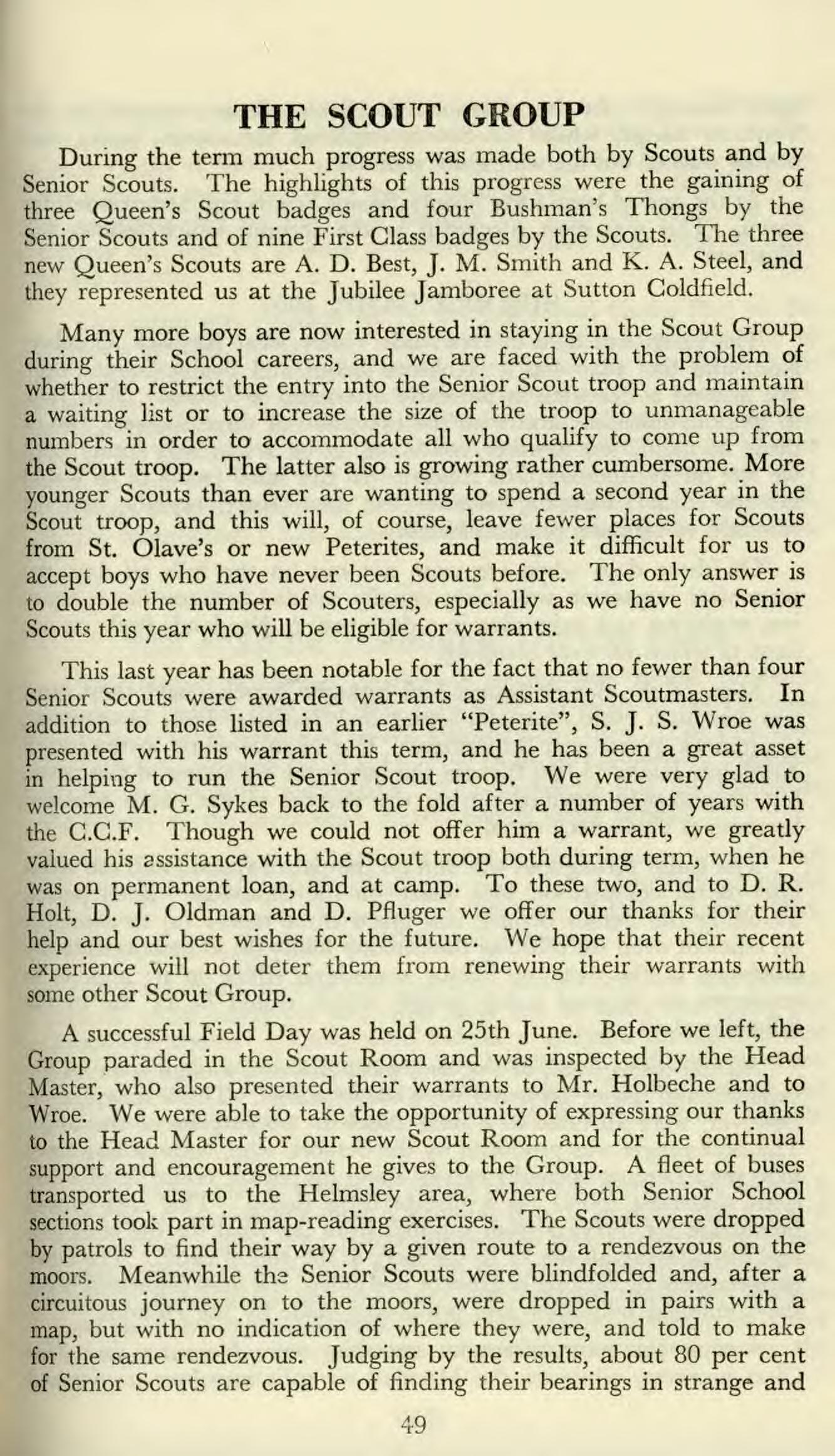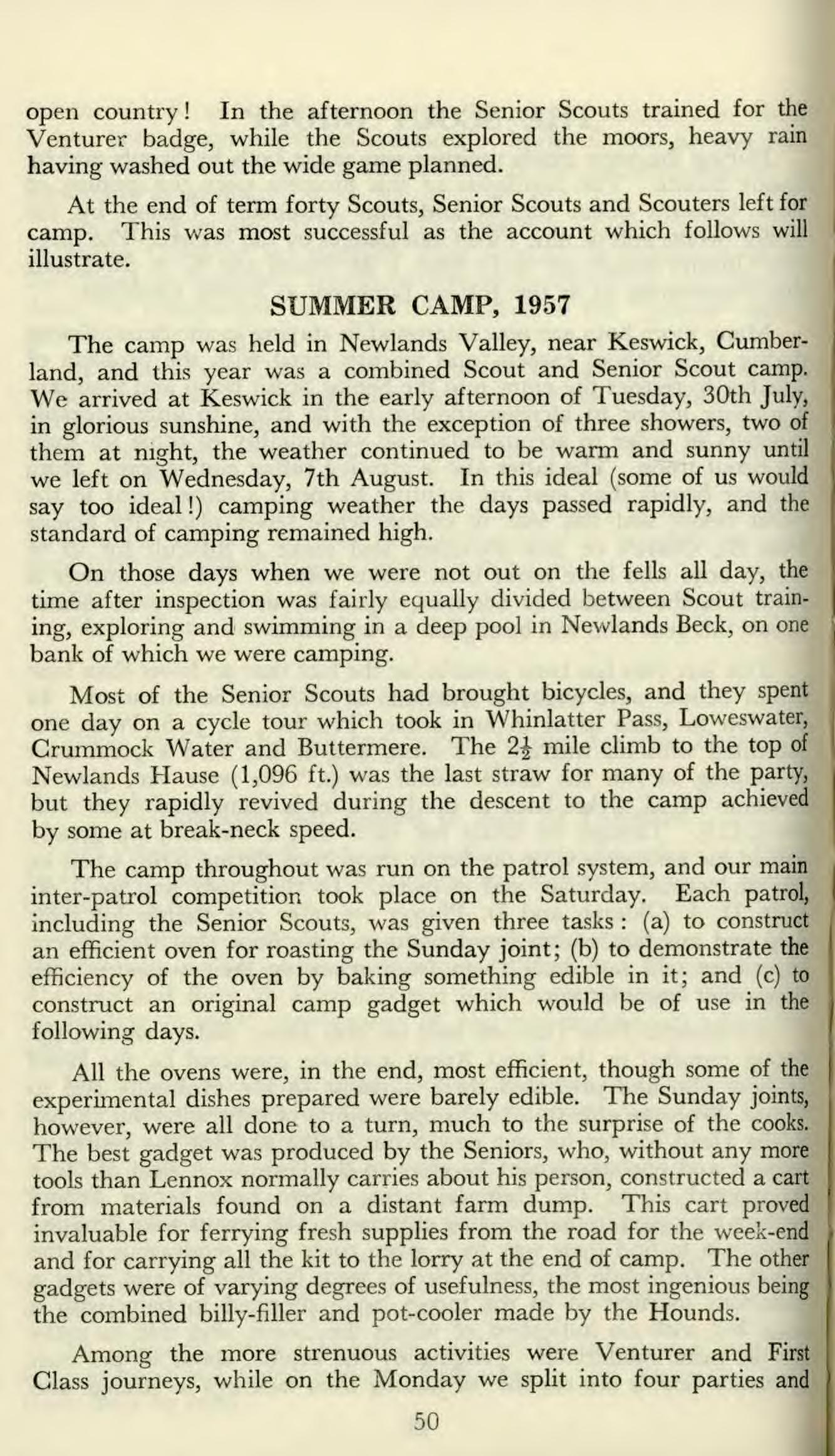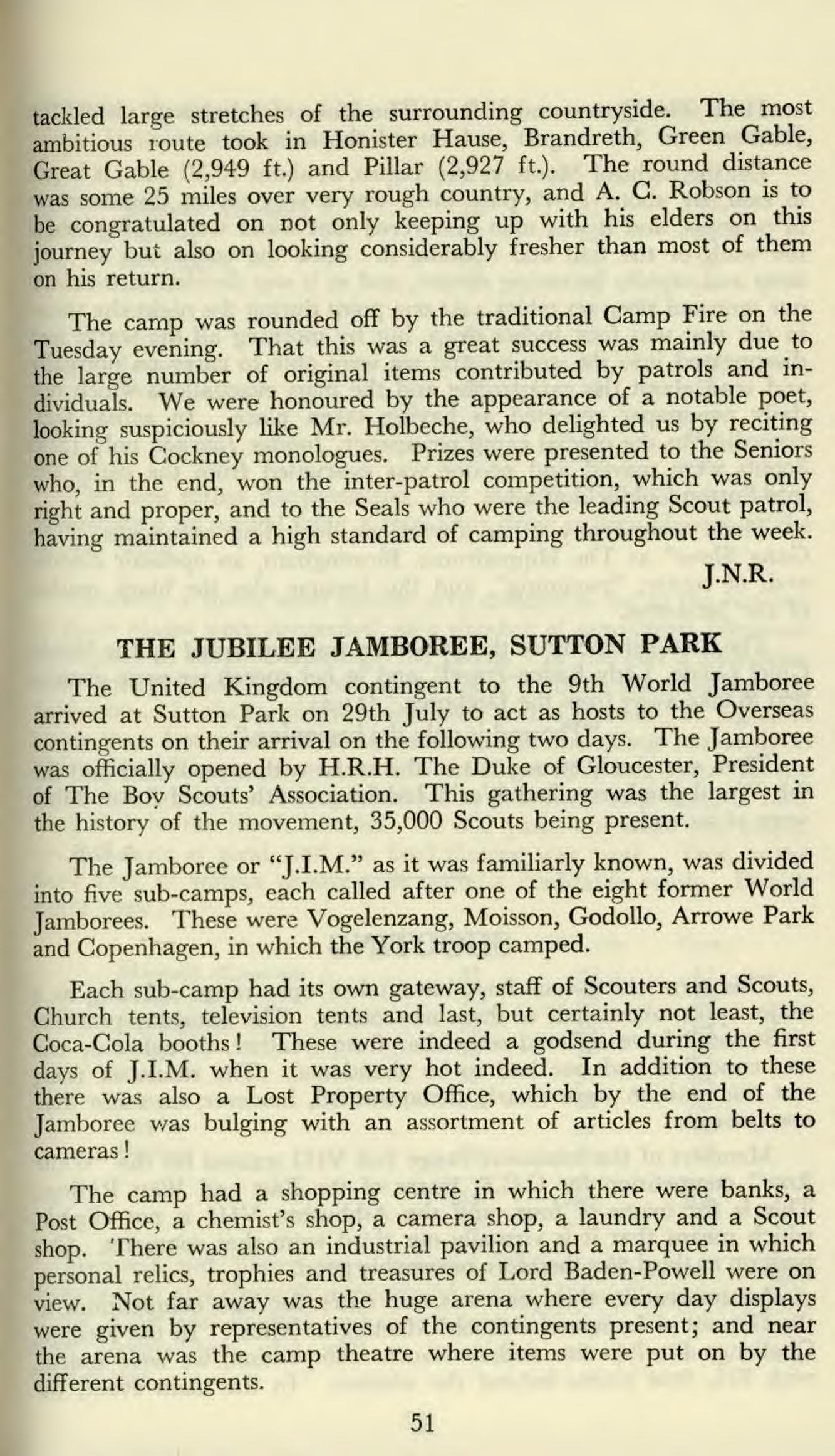
7 minute read
Scouting
from Oct 1957
by StPetersYork
THE SCOUT GROUP
During the term much progress was made both by Scouts and by Senior Scouts. The highlights of this progress were the gaining of three Queen's Scout badges and four Bushman's Thongs by the Senior Scouts and of nine First Class badges by the Scouts. The three new Queen's Scouts are A. D. Best, J. M. Smith and K. A. Steel, and they represented us at the Jubilee Jamboree at Sutton Goldfield.
Many more boys are now interested in staying in the Scout Group during their School careers, and we are faced with the problem of whether to restrict the entry into the Senior Scout troop and maintain a waiting list or to increase the size of the troop to unmanageable numbers in order to accommodate all who qualify to come up from the Scout troop. The latter also is growing rather cumbersome. More younger Scouts than ever are wanting to spend a second year in the Scout troop, and this will, of course, leave fewer places for Scouts from St. Olave's or new Peterites, and make it difficult for us to accept boys who have never been Scouts before. The only answer is to double the number of Scouters, especially as we have no Senior Scouts this year who will be eligible for warrants.
This last year has been notable for the fact that no fewer than four Senior Scouts were awarded warrants as Assistant Scoutmasters. In addition to those listed in an earlier "Peterite", S. J. S. Wroe was presented with his warrant this term, and he has been a great asset in helping to run the Senior Scout troop. We were very glad to welcome M. G. Sykes back to the fold after a number of years with the C.C.F. Though we could not offer him a warrant, we greatly valued his assistance with the Scout troop both during term, when he was on permanent loan, and at camp. To these two, and to D. R. Holt, D. J. Oldman and D. Pfluger we offer our thanks for their help and our best wishes for the future. We hope that their recent experience will not deter them from renewing their warrants with some other Scout Group.
A successful Field Day was held on 25th June. Before we left, the Group paraded in the Scout Room and was inspected by the Head Master, who also presented their warrants to Mr. Holbeche and to Wroe. We were able to take the opportunity of expressing our thanks to the Head Master for our new Scout Room and for the continual support and encouragement he gives to the Group. A fleet of buses transported us to the Helmsley area, where both Senior School sections took part in map-reading exercises. The Scouts were dropped by patrols to find their way by a given route to a rendezvous on the moors. Meanwhile the. Senior Scouts were blindfolded and, after a circuitous journey on to the moors, were dropped in pairs with a map, but with no indication of where they were, and told to make for the same rendezvous. Judging by the results, about 80 per cent of Senior Scouts are capable of finding their bearings in strange and 49
open country ! In the afternoon the Senior Scouts trained for the Venturer badge, while the Scouts explored the moors, heavy rain having washed out the wide game planned.
At the end of term forty Scouts, Senior Scouts and Scouters left for camp. This was most successful as the account which follows will illustrate.
SUMMER CAMP, 1957
The camp was held in Newlands Valley, near Keswick, Cumberland, and this year was a combined Scout and Senior Scout camp. We arrived at Keswick in the early afternoon of Tuesday, 30th July, in glorious sunshine, and with the exception of three showers, two of them at night, the weather continued to be warm and sunny until we left on Wednesday, 7th August. In this ideal (some of us would say too ideal !) camping weather the days passed rapidly, and the standard of camping remained high.
On those days when we were not out on the fells all day, the time after inspection was fairly equally divided between Scout training, exploring and swimming in a deep pool in Newlands Beck, on one bank of which we were camping.
Most of the Senior Scouts had brought bicycles, and they spent one day on a cycle tour which took in Whinlatter Pass, Loweswater, Crummock Water and Buttermere. The 2f mile climb to the top of Newlands Hause (1,096 ft.) was the last straw for many of the party, but they rapidly revived during the descent to the camp achieved by some at break-neck speed.
The camp throughout was run on the patrol system, and our main inter-patrol competition took place on the Saturday. Each patrol, including the Senior Scouts, was given three tasks : (a) to construct an efficient oven for roasting the Sunday joint; (b) to demonstrate the efficiency of the oven by baking something edible in it; and (c) to construct an original camp gadget which would be of use in the following days.
All the ovens were, in the end, most efficient, though some of the experimental dishes prepared were barely edible. The Sunday joints, however, were all done to a turn, much to the surprise of the cooks. The best gadget was produced by the Seniors, who, without any more tools than Lennox normally carries about his person, constructed a cart from materials found on a distant farm dump. This cart proved invaluable for ferrying fresh supplies from the road for the week-end and for carrying all the kit to the lorry at the end of camp. The other gadgets were of varying degrees of usefulness, the most ingenious being the combined billy-filler and pot-cooler made by the Hounds.
Among the more strenuous activities were Venturer and First Class journeys, while on the Monday we split into four parties and 50

tackled large stretches of the surrounding countryside. The most ambitious route took in Honister Hause, Brandreth, Green Gable, Great Gable (2,949 ft.) and Pillar (2,927 ft.). The round distance was some 25 miles over very rough country, and A. C. Robson is to be congratulated on not only keeping up with his elders on this journey but also on looking considerably fresher than most of them on his return.
The camp was rounded off by the traditional Camp Fire on the Tuesday evening. That this was a great success was mainly due to the large number of original items contributed by patrols and individuals. We were honoured by the appearance of a notable poet, looking suspiciously like Mr. Holbeche, who delighted us by reciting one of his Cockney monologues. Prizes were presented to the Seniors who, in the end, won the inter-patrol competition, which was only right and proper, and to the Seals who were the leading Scout patrol, having maintained a high standard of camping throughout the week. J.N.R.
THE JUBILEE JAMBOREE, SUTTON PARK
The United Kingdom contingent to the 9th World Jamboree arrived at Sutton Park on 29th July to act as hosts to the Overseas contingents on their arrival on the following two days. The Jamboree was officially opened by H.R.H. The Duke of Gloucester, President of The Boy Scouts' Association. This gathering was the largest in the history of the movement, 35,000 Scouts being present.
The Jamboree or "J.I.M." as it was familiarly known, was divided into five sub-camps, each called after one of the eight former World Jamborees. These were Vogelenzang, Moisson, Godollo, Arrowe Park and Copenhagen, in which the York troop camped.
Each sub-camp had its own gateway, staff of Scouters and Scouts, Church tents, television tents and last, but certainly not least, the Coca-Cola booths ! These were indeed a godsend during the first days of J.I.M. when it was very hot indeed. In addition to these there was also a Lost Property Office, which by the end of the Jamboree was bulging with an assortment of articles from belts to cameras !
The camp had a shopping centre in which there were banks, a Post Office, a chemist's shop, a camera shop, a laundry and a Scout shop. There was also an industrial pavilion and a marquee in which personal relics, trophies and treasures of Lord Baden-Powell were on view. Not far away was the huge arena where every day displays were given by representatives of the contingents present; and near the arena was the camp theatre where items were put on by the different contingents.











